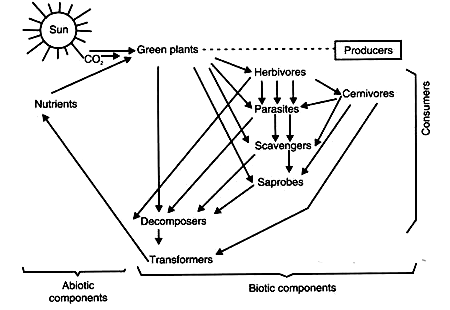UPSC Exam > UPSC Notes > Zoology Optional Notes for UPSC > Ecosystem: Structure and Function
Ecosystem: Structure and Function | Zoology Optional Notes for UPSC PDF Download
| Table of contents |

|
| Ecosystem: Understanding its Structure and Functions |

|
| The Concept of Ecosystem |

|
| Structure of Ecosystem |

|
| Functions of Ecosystem |

|
Ecosystem: Understanding its Structure and Functions
Introduction: Ecosystems, as intricate entities, depict the delicate harmony between organisms and their surroundings. The term "environment" pertains to the elements and conditions surrounding organisms that exert direct or indirect influence on their life and development. This article delves into the concept of ecosystems, highlighting their structure and functions.
The Concept of Ecosystem
Definition of Ecosystem:
- Ecosystems are complex units where habitats, plants, and animals form an interconnected system, with materials and energy flowing between them (Woodbury).
- Organisms and their habitats constitute an ecological complex or ecosystem (Clarke, 1954).
- A.G. Tansley first introduced the concept of ecosystems in 1935, making them the principal ecological unit.
Ecosystem Components:
- Ecosystems possess both structure and functions.
- Structure relates to species diversity, with a more complex structure promoting greater species diversity.
- Functions encompass the flow of energy and material cycling within the ecosystem.
Ecosystem's Size and Interconnectedness:
- Ecosystems come in various sizes, such as a square meter of grassland, a pool, a vast forest, or a river.
- All ecosystems are interconnected; for example, river ecosystems link to ocean ecosystems, and smaller ecosystems, like dead logs, are part of larger forest ecosystems.
- Complete self-sufficient ecosystems are rare in nature, though some approach self-sufficiency.

Structure of Ecosystem
Overview of Ecosystem Structure:
- Ecosystem structure encompasses the organisms, physical environment, nutrient distribution, and prevailing climatic conditions in a specific habitat.
- Abiotic Components:
- The physicochemical environment manifests ecological relationships.
- Includes inorganic elements, soil, water, oxygen, and organic compounds.
- Physical factors like moisture, wind, and solar radiation are integral.
- Radiant solar energy is the primary energy source.
- The standing state refers to the quantity of non-living components like carbon, phosphorus, and nitrogen.
- Biotic Components:
- Encompasses all living organisms in the ecosystem.
- Categorized into:
- Producers (Autotrophic components): Green plants that convert sunlight into chemical energy.
- Consumers: Animals that depend on producers for food.
- Decomposers or reducers and transformers: Fungi and bacteria that break down organic matter.
- Producers, primarily green plants, use sunlight to convert carbon dioxide into chemical energy.
- Oxygen is released as a by-product.
- Algae, grasses, trees, and certain bacteria belong to this category.
- Consumers include herbivores, carnivores, omnivores, and parasites, scavengers, and saprobes.
- Fungi and bacteria decompose dead organic matter, transforming complex compounds into simpler forms.
- Play a vital role in maintaining ecosystem dynamics.
Functions of Ecosystem
Ecosystem as a Functional Unit:
- Ecosystems are discrete environmental systems consisting of biotic and abiotic components.
- Biotic components encompass living organisms, while abiotic components include inorganic matter and energy.
- The sun provides energy input in the form of solar energy.
- Inorganic Constituents: Comprise air, water, and mineral salts.
- Organisms: Include plants, animals, and microbes.
- Energy Input: Solar energy from the sun.
- Energy from the sun is captured by green plants through photosynthesis and is transferred through the ecosystem.
- Nutrients are cycled from abiotic to biotic components and vice versa.
- Energy flow is unidirectional, while nutrient components are recycled.
- Ecosystems in different habitats, such as deserts, forests, grasslands, and seas, are interdependent.
- Energy and nutrients can move between ecosystems, demonstrating the interrelatedness of the Earth's ecosystems.
- Reception of solar energy.
- Conversion of inorganic constituents into organic materials by producers.
- Consumption of producers by consumers and further elaboration of consumed materials.
- Decomposition of dead organic matter by decomposers and transformers, releasing energy and inorganic components.
Conclusion: Understanding the structure and functions of ecosystems is essential for comprehending the intricate balance of life on Earth. Ecosystems serve as interconnected units where species diversity, energy flow, and nutrient cycling play pivotal roles in maintaining the biosphere's functionality.
The document Ecosystem: Structure and Function | Zoology Optional Notes for UPSC is a part of the UPSC Course Zoology Optional Notes for UPSC.
All you need of UPSC at this link: UPSC
|
198 videos|351 docs
|
Related Searches















